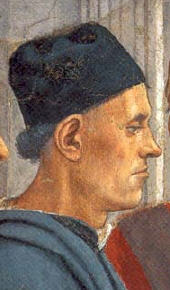General Links
- Pulci, biography English
- Pulci (biography Italian)
- Long Italian biography with details on brothers
- Antonia Pulci - sister-in-law of Luigi, poetress
- The Pulci-House
- Note on Luca Pulci
- Jacob Burckhardt about poets and also Pulci
Provisional remarks to Luigi Pulci and his role in the Minchiate documents
We can say about the Minchiate the following:The meaning of the word is unclear. In Italian language it is near to:
- minchionaggine - Foolishness, stupidity
- minchionare - to make a joke of, to laugh about
- minchionatore - mocker
- minchionatura - mockery
- minchione - Fool
- minchioneria - stupidity
Raimundo Luberti has observed, that Burchiello around 1440 made a poem, in which both words, Trionfi and minchiattar, appear. Burchiello was a barber in Florence and he amused his guests during his work with poems, which he could invent rather spontaneously. We should remember: Florence was a republic in a world with not much other republics and the natural victims of mockery inside a republic should have been the customs in cities and states, which had been not republics. Cause of that: If other cities made Trionfi and triumphal processions (which they did just at the specific time of the invention of the Trionfi cards), it could easily happen, that in Florence a barber or another poet found expressions of mockery commenting these customs. We also have to remember: The Minchiate was a game and it was the name of a game in Florence, not elsewhere.
Burchiello was a funny man, but also Pulci was a funny man (also from Florence). Specific fun Pulci made of the hero Orlando (in the late 60ies of 15th century) and the theme jumped to Count Matteo Maria Boiardo, who started his work in the mid 70ies (Boiardo's Orlando also was "funny"). From Boiardo the theme came to Ariost (50 years later) and this work got a very high rank in the history of literature. Still it had rather humorous accents. Boiardo, we've to remember, wrote a poem about a Trionfi game, which also was considered as "being funny", as Viti mentioned.
This above mentioned "funny" Pulci wrote in the year 1466 a letter to Lorenzo de Medici, who was then a young man of 17 years and just from that generation, which loved card playing a little more than chess. In this letter the word Minchiate is mentioned. It's not funny, but the letter is unluckily lost. Lorenzo de Medici, we've to remember, wrote later carnival songs and triumphal processions merged with carnival processions under his reign (and carnival has something to with fun, you should know, although not everybody knows that). Later it was said, that Lorenzo corrupted the youth, but mostly it's said, that Florence never had a better time. The latter was not the opinion of Savonarola (1494) after Lorenzo's reignment and he urged the Florentian population to burn unbelievable lots of playing cards beside many other items of art, so that each art historian has running tears when memorizing the barbarical acts. Finally the Florentian population burnt Savonarola.
In 1471 the game called Minchiate appeared as "prohibited" (rather far away from Florence). In 1477 the game called Minchiate is called an "allowed" game. (See here).
Until now there is no way to give any sensemaking consideration, how this Minchiate, mentioned at this three occasions, looked like. We cannot assume with any security, that it already had 97 cards for instance. Also we cannot be sure, if not some of these Trionfi deck fragments surviving from 15th century in 15th century reality had been not Minchiate decks. Longer time it was considered, that Minchiate appeared first time around 1530. This was contradicted by the researches of Franco Pratesi (around 1990).
Pulci was a sort of teacher to the young Lorenzo de Medici - and an important man in the neoplatonic academy of Florence in the 60ies.
After all these considerations it seems a little difficult to make much sense of details in the given order of the Minchiate as it had come to us. Especially, as we come across these many variants of different numerologies inside the general Tarot development in 15th/16th century. One point seems clear: the begin was a little fun or mockery inside the heads of some highspirited persons around the neoplatonic academy of Florence with some sense for intellectual humour.
(Huck Meyer)
